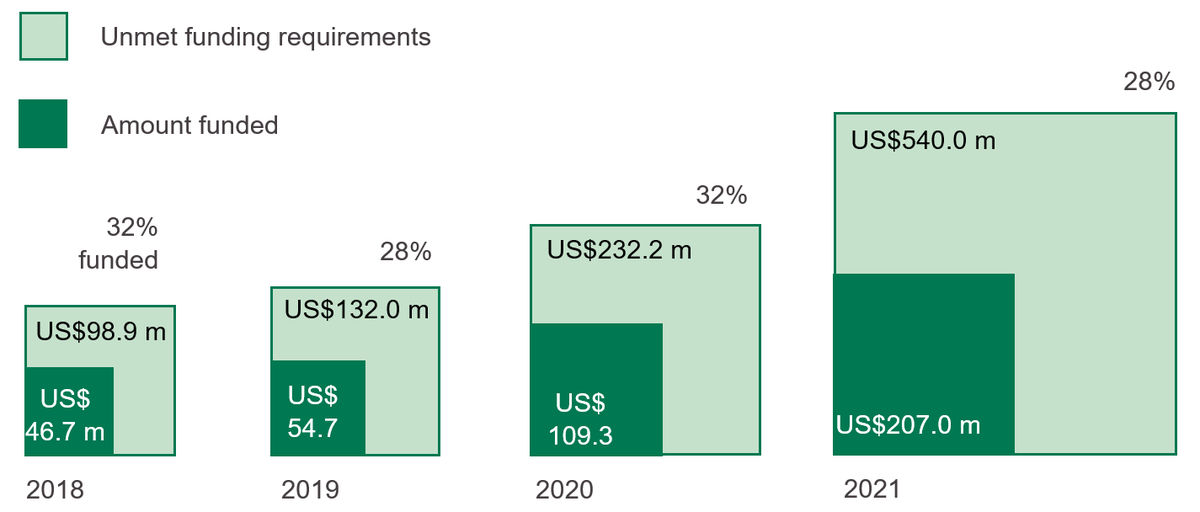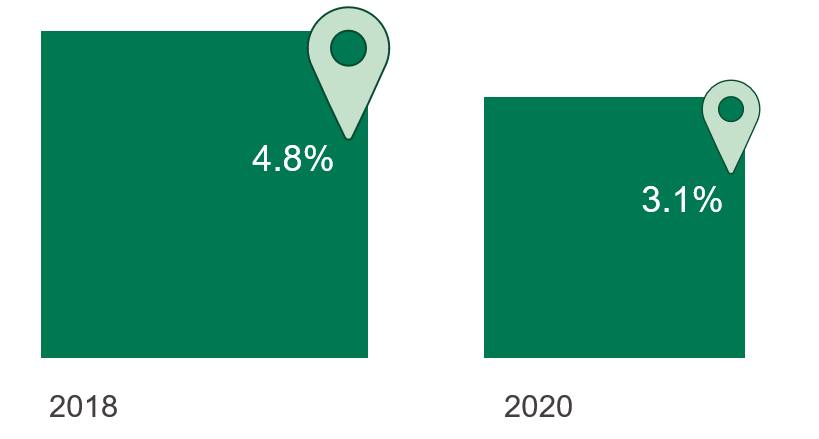The needs of women and girls in humanitarian crises, compounded by the Covid-19 crisis, have increased rapidly, setting back progress on gender equality and the empowerment of women and girls. Despite the high profile of gender-related issues within humanitarian policy, and increases in funding for gender equality and to support women and girls in humanitarian crises, global efforts have fallen short during Covid-19. This report presents analysis of the latest available data alongside insights from those working in the sector. It shows that current delivery, tracking and reporting of funding for gender equality and the empowerment of women and girls in humanitarian crises does not ensure that the needs of those experiencing crises are fully understood or met, and it reinforces the urgent need for system reform.
Key findings
1. Despite gender-specific funding rising, it is not keeping pace with rapidly increasing needs

| 2018 | 2019 | 2020 | 2021 | |
|---|---|---|---|---|
| Amount funded | 47 | 55 | 109 | 207 |
| Unmet requirements | 99 | 132 | 232 | 540 |
|
% Requirements
met |
32% | 29% | 32% | 28% |
Refer to report Figure 2.4 for source and notes
- Between 2018 and 2021, the volume of gender-specific funding within international humanitarian assistance increased by 108%, while international humanitarian assistance overall flatlined during this time.
- There is a lack of data on the needs of women and girls and how well funded these are. However, gender-based violence (GBV) is an area of response where data allows for better tracking of funding, and here we see consistent underfunding between 2018 and 2021, with only a quarter of funding requirements (28%) met in 2021. This compares with an average for all appeal requirements of 51%. It is likely that other rising gender-related needs are also consistently underfunded.
2. Commitments to localise funding have not materialised

| 2018 | 2019 | 2020 | 2021 | |
|---|---|---|---|---|
|
Gender-specific funding to
local and national organisations |
12.3 | 16.2 | 10.8 | 7.8 |
|
All other gender-specific
international humanitarian assistance |
254.1 | 322.8 | 352.0 | 547.0 |
|
Proportion of gender specific
funding to LNOs |
4.8% | 5.0% | 3.1% | 1.4% |
Refer to report Figure 2.9 for source and notes
- The proportion of total gender-specific funding directly provided to local and national actors has reduced from 4.8% in 2018 to 3.1% in 2020.
- Feedback from local NGOs reveals a systemic process that excludes smaller NGOs not set up for ‘traditional’ funding processes with heavy bureaucracy and a frustration of local voices missing from decision-making.
3. Overreliance on a small number of donors leaves funding vulnerable

| Donor | GBV funding | Other gender-specific funding |
|---|---|---|
| US | 20.1 | 94.4 |
| EU institutions | 13.5 | 36.9 |
| Norway | 26.8 | 23.0 |
| Canada | 18.0 | 15.1 |
| Japan | 17.4 | 12.9 |
| Sweden | 17.8 | 6.9 |
| Australia | 10.4 | 12.4 |
| UK | 11.7 | 7.4 |
| Germany | 3.0 | 13.2 |
| Italy | 7.7 | 1.9 |
| All other funding | 19.4 | 24.3 |
Refer to report Figure 2.5 for source and notes
- Between 2018 and 2021, 87% of gender-specific international humanitarian assistance came from just 10 donors, such that a cut from just one could considerably impact the overall funding pot.
- The burden of meeting gender-related funding needs is not equally shared among an already-small pool of donors. In 2021, three donors provided more than 6% of their total humanitarian assistance for gender-specific programmes, while for the four largest donors of total international humanitarian assistance, 2% or less of their funding was identifiable as gender specific.
4. Lack of good reporting is preventing donors and other humanitarian actors from effectively meeting the needs of women and girls in crisis

An infographic showing three circles with the following text. First circle: "There were 39 countries with UN-coordinated appeals in 2020."; Second circle: "The GAM was applied in only 25 countries - across c. 5,000 projects"; Third circle: "Completed GAM scored were published for just half of these, c. 2,500 projects."
Refer to report Figure 3.1 for source and notes
- It is currently voluntary to report to humanitarian data platforms, and levels of reporting are inconsistent across humanitarian actors.
- There is currently not a standard way of marking gender spending across reporting systems, making tracking complicated and time-consuming.
► Read more from DI about gender
► Share your thoughts with us on Twitter or LinkedIn
► Sign up to our newsletter
Recommendations
- Donors must protect and sustain current levels of funding and more equally share the burden of providing gender-related funding.
- Donors must provide more multi-year and flexible funding and, where possible, more must be given directly to local and national actors.
- UN agencies and international NGOs (INGOs) must pass on more funding, including more multi-year and flexible funding, to local women-led and women’s rights organisations.
- All humanitarian actors should include local women’s rights and women-led organisations in coordination, planning and decision-making on gender funding and programming in delivering their commitments to localise funding.
- The International Aid Transparency Initiative (IATI), OECD Development Assistance Committee Creditor Reporting System (CRS) and UN OCHA Financial Tracking Service (FTS) must strengthen gender markers currently available on aid data platforms. This will improve transparency on where gender funding is going, especially gender-mainstreamed funding, and streamline the reporting process to improve service delivery and maximise the impact of limited funds.
- Donors, UN agencies and INGOs should consistently report to aid data platforms on gender funding.
All UN member states committed to achieving the Sustainable Development Goals and specifically SDG 5 (achieve gender equality and empower all women and girls), but they risk significant setbacks on progress unless we act on the recommendations made in this report. The way in which funding is delivered is in urgent need of reform as crises continue to manifest and unfold, driving increasing need across the world. Crucially, better tracking of funds ensures that the needs of women and girls and gender equality in humanitarian crises can be supported and that those in need are not being left behind.